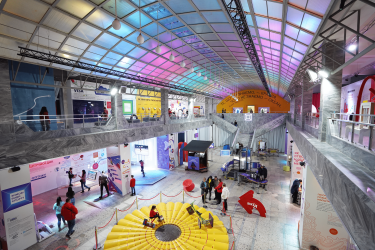Ecsite member Support for Ukraine
Since the start of the War, our members have been supporting colleagues in Ukraine with exhibitions to promote science engagement during these troubled times. Ecsite wants to highlight the outstanding efforts of our members.
Ecsite hosted our Ukrainian members during the 2022 Conference in Heilbronn with a swapping wall, encouraging offers of support. But even before this, colleagues from Experimentarium in Copenhagen, Denmark were busy planning how to donate and ship an exhibition to the Junior Academy of Sciences in Ukraine.
We spoke to Sheena Laursen, Programme Manager for International Relations and Learning Experiences at Experimentarium in Denmark to understand where the idea came from and just how they went about making good on their promise.
So, Sheena, where did the idea come from?
Just after the start of the War, we had an Ecsite Conference Programming Committee (ACPC) meeting, in which I sat with Vasyl Dunets, Head of the Department for Education Programmes at the Junior Academy of Sciences in Kyiv, Ukraine. Vasyl mentioned that children can't always go to school, but they can come to a science centre for some hours. I had an idea and went back to Experimentarium to see what we could do to help. At the following Ecsite conference in Heilbronn our director Kim Gladstone Herlev and I met up with Vasyl and his team to discuss future collaborations.
What exhibition did you donate?
We donated the Winter Sports exhibition, where visitors explore many different winter sports and learn the science and technology behind them. The Winter Sports exhibition was in our possession. Originally we built the exhibition in 2008 together with Heureka, Finland, Tekniska museet, Sweden and the VilVite Science Centre in Norway. We developed traveling exhibitions together for some years and rotated them between us.
What challenges did you face?
We had immediate support to donate the exhibition but it was a real challenge transporting it to Ukraine. We are a non-profit organisation and were not able to cover the costs of the shipping. We looked into many different alternatives and just as we were about to give up, Mærsk stepped in and offered to not only cover the costs of the transportation but also handle the logistics and transportation itself. Another challenge was transferring the knowledge of how to install the exhibition, because no one from the Junior Academy of Sciences in Kyiv could come and experience it or follow things being packed up. To solve this, we made a film of the dismantling and packing and sent it to the Ukrainian team. It all worked out, even better than we imagined, and they were able to install it themselves with the film as a guide.
What tips could you give to someone else wanting to send an exhibition?
You need somebody to champion it, to keep going on about this being a good idea because in the beginning, people did wonder a little bit about it. They were like, “There's a war! That would be ridiculous! Why would they want an exhibition?” But I kept assuring people that the exhibition would be both relevant and valued for the people of Ukraine and of course Vasyl and his team’s appreciation supported this discussion.
Is there anything else you would like to add?
I would just say that the best way of being sustainable is recycling. Giving our Winter Sports exhibition a new life in Ukraine is also an excellent way to recycle a popular exhibition.
We asked Vasyl for his thoughts on the kind donation…
When we can, we would like to invite Sheena Laursen and Kim Gladstone Herlev – Executive Director from Experimentarium to see this exhibition in the Kyiv Science Museum. We would like to thank the team at Experimentarium for their generosity and support for the Junior Academy of Science on behalf of all museums and centres of knowledge based in Ukraine during this difficult period.

